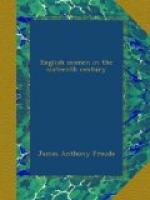a hurry. Perhaps he was in time to save Vigo itself.
Perhaps Drake, having other aims in view, did not
care to be detained over a smaller object. The
Governor, at any rate, saw that the English were too
strong for him to meddle with. The best that
he could look for was to persuade them to go away
on the easiest terms. Drake and he met in boats
for a parley. Drake wanted water and fresh provisions.
Drake was to be allowed to furnish himself undisturbed.
He had secured what he most wanted. He had shown
the King of Spain that he was not invulnerable in his
own home dominion, and he sailed away unmolested.
Madrid was in consternation. That the English
could dare insult the first prince in Europe on the
sacred soil of the Peninsula itself seemed like a dream.
The Council of State sat for three days considering
the meaning of it. Drake’s name was already
familiar in Spanish ears. It was not conceivable
that he had come only to inquire after the arrested
ships and seamen. But what could the English
Queen be about? Did she not know that she existed
only by the forbearance of Philip? Did she know
the King of Spain’s force? Did not she
and her people quake? Little England, it was
said by some of these councillors, was to be swallowed
at a mouthful by the King of half the world.
The old Admiral Santa Cruz was less confident about
the swallowing. He observed that England had many
teeth, and that instead of boasting of Spanish greatness
it would be better to provide against what she might
do with them. Till now the corsairs had appeared
only in twos and threes. With such a fleet behind
him Drake might go where he pleased. He might
be going to the South Seas again. He might take
Madeira if he liked, or the Canary Islands. Santa
Cruz himself thought he would make for the West Indies
and Panama, and advised the sending out there instantly
every available ship that they had.
The gold fleet was Drake’s real object.
He had information that it would be on its way to
Spain by the Cape de Verde Islands, and he had learnt
the time when it was to be expected. From Vigo
he sailed for the Canaries, looked in at Palma, with
’intention to have taken our pleasure there,’
but found the landing dangerous and the town itself
not worth the risk. He ran on to the Cape de
Verde Islands. He had measured his time too narrowly.
The gold fleet had arrived and had gone. He had
missed it by twelve hours, ‘the reason,’
as he said with a sigh, ’best known to God.’
The chance of prize-money was lost, but the political
purpose of the expedition could still be completed.
The Cape de Verde Islands could not sail away, and
a beginning could be made with Sant Iago. Sant
Iago was a thriving, well-populated town, and down
in Drake’s book as specially needing notice,
some Plymouth sailors having been recently murdered
there. Christopher Carlile, always handy and
trustworthy, was put on shore with a thousand men to
attack the place on the undefended side. The




